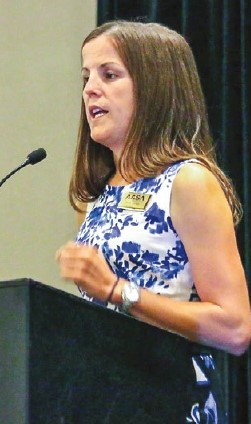Noelle Ellerson Ng on Rural Schools Advocacy
April 01, 2017

Inside AASA
Despite the fact that a third of all public schools are in rural areas and one-quarter of school students are enrolled in rural schools, federal education policy does not always reflect the reality all public of rural public education. Noelle Ellerson
Ng, associate executive director of policy and advocacy, and Assistant Director Sasha Pudelski head up activities related to rural school districts. The department presents at state association meetings on federal policy issues and works on Capitol
Hill to educate federal policymakers on K12 education issues.
The following interview by AASA managing editor Liz Griffin has been edited for length and clarity.
Describe our rural school members and how their concerns differ from urban and suburban superintendents.
Superintendents in small districts are often the principal, the substitute social studies teacher, the bus driver, the head of finance, the curriculum director and so on, wearing the proverbial 17 hats. This is true for other staff as well. In one
isolated K-8 district in Montana I visited, there were 14 students; multiage groupings were common and teachers taught several grade levels.
In contrast to suburban and urban districts, rural schools may be disproportionately isolated
from other communities, with no other schools or communities within 50 miles. Isolation brings unique challenges for such things as connectivity, transportation, and recruiting and retaining staff.
Can you elaborate on connectivity challenges in isolated districts?
It is not uncommon to have only one internet service provider in a rural area say that it is not possible or profitable to lay down lines in outlying areas. Even when service is available, high-speed bandwidth may be prohibitively expensive. The
end result is that rural districts may have insufficient bandwidth to deliver online courses.
Improving connectivity is hugely important because a rural district cannot justify hiring a teacher if only one student is qualified to take say,
AP Calculus, an option that a larger district where 20 or more students are qualified can justify.
What about other challenges?
Figuring out transportation in a sparsely populated area is very different than in a suburb or city. Rural superintendents often face high staff turnover and difficulty in recruiting because salaries in their districts are lower and job opportunities
for a partner are fewer.
Currently, are federal education policy and rural school reality out of sync?
Federal policymakers are professional policymakers, but not experts in education. They may not recognize nuances of how legislation will impact rural schools differently. That is why AASA is always talking to people on the Hill and educating them about
the diversity among school districts. It’s an ongoing conversation, and it’s best when we are on the front-end of that dialogue.
Consider legislation requiring well-qualified teachers in every classroom. While that’s a
highly desirable goal, it simply may not be possible in an isolated, rural district. The Montana district with 14 students was more than 50 miles from another district. One teacher taught K-2. To comply with regulations, that teacher would have to
have 9 certifications! So districts must balance the desirability of certifications with reality.
What are the goals of AASA’s advocacy efforts for rural schools?
The vast majority of issues that school superintendents face – whether they are rural, suburban or urban – are the same. The core issues include looking for ways to improve opportunities for students, to address learning gaps, to hire
and retain qualified staff, to provide transportation and to ensure equity.
We look at new administrative burdens, competitive funding streams, and mandates from the viewpoint of rural school leaders. How will they be able to comply?
How do we ensure their districts will receive this money? How will reporting a few more pieces of data impact the day-to-day of the school administrator who wears many hats?
How has the Rural Education Achievement Program helped rural school leaders?
AASA helped create the REAP program in the late 1990s and it remains a direct, dedicated and flexible source of revenue for rural school leaders. During the latest reauthorization of the Every Student Succeeds Act, we ensured the program was updated to
be targeted towards districts that are truly rural.
Who does AASA work with to advance rural district agendas?
Two groups are key: the National Rural Education Association (to which any individual can belong) and the National Rural Education Advocacy Consortium (a group of 20 members, including AASA staff). These two groups provide an analysis of federal policy
through a rural lens. A monthly call between NREAC’s 20 members gets summarized by Ellerson and Pudelski and pushed out to members.
Can rural members contact members of the advocacy team to discuss specific concerns?
Yes! That is our job to be available to provide information and updates on federal policy. Sasha and I receive many invitations to speak at state association meetings.
What events and resources may interest rural members?
The AASA Policy Blog is a free member service. All you need to do is send me an e-mail (Noellerson@aasa.org) and put “Subscribe Policy Blog” in the subject line. I would also recommend attending the Advocacy Conference in July, which gives attendees a chance to speak with their representatives and the National Conference on Education.
Author
Advertisement
Advertisement
Advertisement
Advertisement




